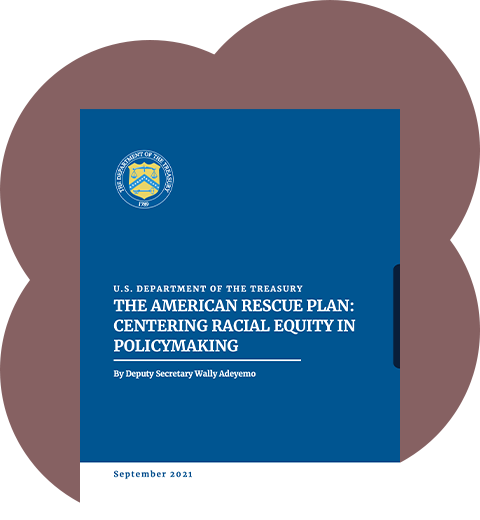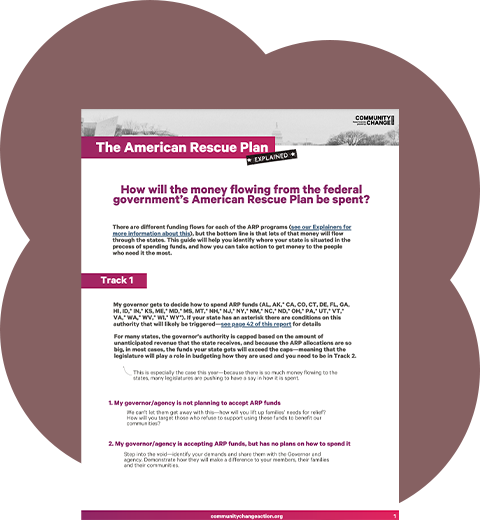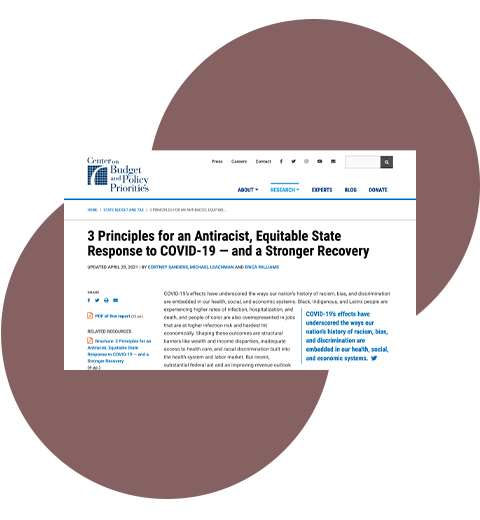Introduction
As described more fully in the State and Local Fiscal Recovery Funds (SLFRF) Guidelines, SLFRF spending categories are purposefully broad. Rather than direct how cities, counties, states, territories and tribal governments must use the funds they get, Congress and the Treasury Department have given them the flexibility to decide what their communities need to recover from the pandemic. This means that SLFRF implementation will look different from one locale to the next. It also means that there are likely to be many different and competing uses for the funds in any given place.
Local organizers should prepare to advocate for equitable and effective use of SLFRF in your community, just as you would with any other campaign to win a program or policy change. Framing your arguments, finding other people to support your efforts, and communicating what you want to your elected officials and the media will all be important to winning the SLFRF outcomes you want.
Advocacy Checklist
States and localities can use State and Local Fiscal Recovery Funds (SLFRF) to support communities where everybody has what they need to thrive. SLFRF rules and guidance from the Biden Administration encourage states and localities to use their funds to address needs caused or made worse by the pandemic.
As you prepare to advocate for how you want the funds to be used in your community, the following questions can help shape your strategy and demands.
① How much money is coming to my state/locality?
② How much of the SLFRF allocation has already been obligated or spent?
③ Who is responsible for making decisions about SLFRF and what decision-making process will they use?
This may be the most difficult question to answer. In some cases, your Governor or Mayor might have the authority to decide how to spend funds. In other cases, they might need to work with the legislature or other governing body like a city council, city manager, county commission, appointed board or committee. Decisions might be made through the normal budgeting process, or special procedures (like task forces or working groups) may have been set up to guide the use of funds. One way to figure this out is to contact an elected official who is your ally for insight, and if you don’t have a champion already, now is the time to reach out and start building relationships.
④ Has your state/locality established opportunities for public engagement?
Community surveys, town halls, public hearings, and other forums can be important ways to inject your ideas into the decision-making process. If your elected officials haven’t set these up already, add public participation to your demands.
⑤ How do I think the SLFRF should be used?
⑥ How can I get involved?
This page provides ideas and tools for getting involved, and you can search for additional resources on the Resources page.
Equitable Decision-making for SLFRF
Best Practices for Equitable Decision-making
The State and Local Fiscal Recovery Funds (SLFRF) program is intended to provide cities, counties, states, tribes and territories with the resources they need to begin to build a more equitable economy as they recover from the pandemic. In its rules, the Treasury Department recognizes that addressing long term, structural barriers to health and economic well-being are a key step to helping people and communities with low incomes, and people and communities of color who were disproportionately affected by the pandemic.
While the law creating SLFRF encourages states and localities to use funds to promote an equitable recovery, it also created enough flexibility that states and localities can spend funds in ways that are totally unrelated to the hardships created by the pandemic. Advocates and elected officials have a historic opportunity to use American Rescue Plan funds strategically and deliberately to begin to address long-standing racial and economic inequities that were exposed and exacerbated by the pandemic.
Public Engagement and Transparency
Transparency is the foundation for any meaningful public engagement process. For members of the public to play a role in decision-making, they must be aware of the fact that the city, county or state has SLFRF funds to spend, and understand how they can make their voices heard. Publicizing the availability of funds, soliciting ideas and feedback from residents through surveys and public meetings, and making decisions through processes that are open to everyone are critical components to public engagement. The SLFRF final rule, which permits recipients to spend SLFRF on these community outreach and engagement activities, reflects the Treasury Department’s support for public engagement.
Local officials across the country are committed to engaging their constituents and being accountable to their input, using dashboards, trackers, and public reports—like these examples from Syracuse, NY, LA County, CA and Franklin County, OH—for transparency in decision-making.
Equitable Use of Funds
What’s at Stake
The State and Local Fiscal Recovery Funds (SLFRF) provided under the American Rescue Plan represent a historic opportunity for states and localities to make significant investments to address historic inequities and ensure an equitable recovery from the COVID-19 pandemic.
Unfortunately, the law creating SLFRF provided enough flexibility that states and localities can spend funds in ways that are totally unrelated to the hardships created by the pandemic. Governments do not have to get permission from the Treasury Department before deciding how to spend SLFRF funds. Policymakers and community groups who want to make the most of SLFRF must get engaged and fight for equitable and effective investment of these funds. As always, without advocacy, even this historic opportunity could be lost.
Allowable Use of Funds and What They Mean
SLFRF dollars are very flexible compared to previous rounds of recovery funding. Organizers can put this flexibility to use by identifying your community’s needs. Among other things, you can use SLFRF to:
- Address public health and economic impacts of the pandemic
- Cover premium pay for frontline workers
- Strengthen government services by making up for lost revenue
- Build and repair water, sewer & broadband systems
- Increase direct cash assistance to families
- Provide rent, mortgage or utility assistance
- Support weatherization or Internet access
- Offer digital literacy, job training, and other creative programs and projects that respond to particular needs in your community



